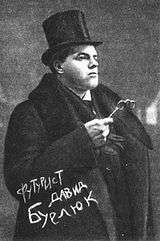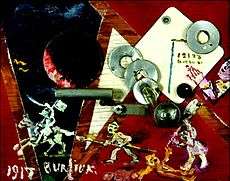David Burliuk
| David Burliuk | |
|---|---|
|
Burliuk in 1914, aged 32 | |
| Born |
David Davidovich Burliuk 21 July 1882 Riabushky, Russian Empire (now Lebedyn District, Sumy Oblast, Ukraine) |
| Died |
15 January 1967 (aged 84) Long Island, New York |
| Nationality | Ukrainian |
| Literary movement | Russian Futurism |
David Davidovich Burliuk (Ukrainian and Russian: Дави́д Дави́дович Бурлю́к; 21 July 1882 – 15 January 1967) was a Russian and Ukrainian Futurist, Neo-Primitivist, book illustrator, publicist, and author associated with Russian Futurism. Burliuk is often described as "the father of Russian Futurism."
Biography
Early life
David Burliuk was born in 1882 in Semyrotivka near the village of Riabushky (now Lebedyn District, Sumy Oblast) in the Kharkov Governorate of the Russian Empire (present-day Ukraine), brother of fellow artist Volodymyr (Wladimir) Burliuk in a family partly descended from Ukrainian Cossacks who held premier positions in the Hetmanate. His mother, Ludmila Mikhnevich, was of ethnic Belarusian descent. Because of his given name of "David," Burliuk was frequently mistaken for being Jewish.[1]
Education, career


From 1898 to 1904 he studied at Kazan and Odessa art schools, as well as at the Royal Academy in Munich. His exuberant, extroverted character was recognized by Anton Azhbe, his professor at the Munich Academy, who called Burliuk a “wonderful wild steppe horse.”[2]
In 1908 an exhibition with the group Zveno ("The Link") in Kiev was organized by David Burliuk together with Wladimir Baranoff-Rossine, Alexander Bogomazov, his brother Volodymyr (Wladimir) Burliuk and Aleksandra Ekster. In 1909 Burliuk painted a portrait of his future wife, Marussia, on a background of flowers and rocks on the Crimean coast. Many times thereafter he would set the image of his wife to canvas. Without question two dreams possessed his heart all his life: the face of his wife and the portrait of his homeland - first Ukraine and then his adopted country, the United States.
The Futurist literary group Hylaea (Russian: Гилея [Gileya]) was initiated in 1910 by David Burlyuk and his brothers at their estate near Kherson, and quickly joined by Vasily Kamensky and Velimir Khlebnikov, with Aleksey Kruchenykh and Vladimir Mayakovsky joining in 1911[3])
From 1910 he was the member of the group Jack of Diamonds, and from 1910 to 1911 he attended the Art School in Odessa. After 1911 David concentrated on poetry. From 1911 to 1913 he studied at the Moscow School of Painting, Sculpture and Architecture (MUZHVZ), and that year participated in the group exhibition of the Blaue Reiter in Munich, which also included his brother Wladimir.
In December 1912 David Burliuk was co-author of the manifesto A Slap in the Face of Public Taste with the other members of Hylaea, said to be the start of Russian Futurism, a movement of Russian poets and artists who adopted the principles of Filippo Marinetti's "Futurist Manifesto".
In 1913 he was expelled from the Academy. In the same year D. Burliuk founded the publishing venture of the futuristic writer's group Hylaea. In 1915 David Burliuk published the book The Support of the Muses in Spring, with illustrations by Lentulov, and by David and Wladimir Burliuk.

From 1915 to 1917 he resided in the Urals with frequent trips to Moscow and Petrograd (St. Petersburg).[4] In 1917 he participated in an exhibition with the group Jack of Diamonds in the artists' salon in Moscow, which included Aleksandra Ekster and Kazimir Malevich.
In 1916 his brother Wladimir Burliuk was drafted into military service, and in 1917 was killed in World War I in Saloniki. The next year Burliuk began traveling to the United States, a process that took him through Siberia, Japan, and Canada and wasn't complete until 1922.[4]
In 1925 Burliuk was a co-founder of the Association of Revolutionary Masters of Ukraine (ARMU) with the members Alexander Bogomazov, Vasiliy Yermilov, Vadym Meller, Alexander Khvostenko-Khvostov, and Palmov Victor. In 1927 he participated in an exhibition of the Latest Artistic Trends in the Russian Museum in Leningrad (St. Petersburg), together with Kazimir Malevich, Aleksandr Shevchenko, and Vladimir Tatlin.
David Burliuk was author of autobiographical sketches My Ancestors, Forty Years: 1890–1930.
Later years
In 1940, Burliuk petitioned the Soviet government for a request to visit his homeland. In exchange, he offered a sizeable collection of archival material pertaining to his contemporary and friend Vladimir Mayakovsky, which Burliuk offered to donate to the Mayakovsky Museum in addition to over 100 original paintings. Burliuk's requests were denied. He was allowed to visit the Soviet Union only in 1956 and 1965.
In 1945 an exhibit was mounted at Irving Place Theater in New York City[5]
In 1962 he and his wife traveled to Australia where he held an exhibition at Moreton Galleries, Brisbane. It was his only Australian exhibition. During his stay there David Burliuk painted some sketches and works with Australian views. From 1937 to 1966 Burliuk and his wife, Marusia, published Color & Rhyme, a journal primarily concerned with charting Burliuk's activities.[4]
David Burliuk lived in Hampton Bays on Long Island for approximately 20 years until he died on Long Island, New York. His house and studio still remain.
Heritage
In Russian poetry, Burliuk is regarded as a trailblazer. In 1990, the Russian Academy of Futurist Poetry established the David Burliuk Prize (Otmetina) for experimental poetry awarded annually.[6]
Trivia
- A painting (most likely fictional) by Burliuk appears in the novel Chapayev and Void by Viktor Pelevin. The painting is described as a black writing though a stencil of the word GOD.
Gallery
 David Burliuk, Benedict Livshits (1911)
David Burliuk, Benedict Livshits (1911) David Burliuk Cossack Mamay (1912)
David Burliuk Cossack Mamay (1912) David Burliuk, Spring (1914)
David Burliuk, Spring (1914) David Burliuk, Dokhlaya Luna (1914)
David Burliuk, Dokhlaya Luna (1914).jpg) David Burliuk, Portrait of Vasily Kamensky (1917)
David Burliuk, Portrait of Vasily Kamensky (1917) David Burliuk, Mayakovsky (1920)
David Burliuk, Mayakovsky (1920)
Publishing history
- 1912: co-author of the Russian Futurist manifesto A Slap in the Face of Public Taste.
- 1915: The Support of the Muses in Spring
Footnotes
- ↑ Pg. 77, Nabokov and his fiction: new perspectives By Julian W. Connolly
- ↑ 'About David Burliuk' — biography from the Futurism and After: David Burliuk, 1882–1967 exhibition
- ↑ Victor Terras, Handbook of Russian Literature (Yale University Press, 1990), s.v. "Hylaea", p. 197.
- 1 2 3 Stephanie Barron and Maurice Tuchman, The Avant-Garde in Russia, 1910-1939: New Perspectives. Los Angeles, CA: Los Angeles County Museum of Art, 1980; pg. 128.
- ↑ "ARCHITECTURE UNIT PLANS NEW DISPLAY; League Here to Show …". New York Times. Feb 12, 1945. Retrieved 2010-04-01.
- ↑ David Burliuk Prize Homepage
External links
| Wikimedia Commons has media related to David Burliuk. |
- Exhibition Futurism and After: David Burliuk, 1882-1967 The Ukrainian Museum in New York, USA. October 31, 2008 - April 26, 2009
- David Burliuk. Russian Art in America. New York, 1928.
- Exhibition Crossroads: Modernism in Ukraine, 1910-1930,(2006-2007) The Ukrainian Museum in New York, USA.
- REVISITING THE PAST: David Burliuk, father of Ukrainian Futurism in America
- Figureworks.com/20th Century work at www.figureworks.com
- English translations of 4 poems, 1910-1915
- Includes English translations of four poems, 109-112
- English translations of 5 poems, 1910-1916
- David Burliuk: Biographical sketch